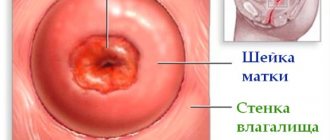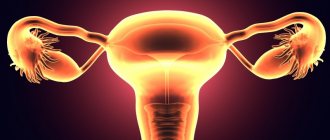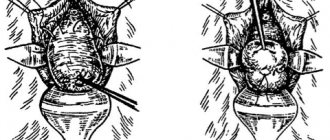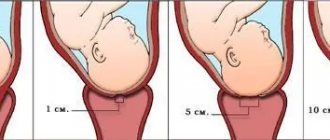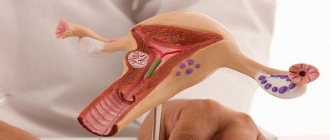Deflection of the uterus: normal or pathological?
Diseases of the female reproductive system are sometimes quite difficult to diagnose. Some pathological changes are discovered only when a woman realizes that despite all her efforts, she cannot get pregnant. After tests and hardware examinations, doctors often make a disappointing diagnosis - a bend of the uterus. According to statistics, this disease occurs in every fifth woman. True, the anomaly is not immediately detected. To understand the mechanism of occurrence and development of the disease, it is worth taking a closer look.
The uterus is a small, hollow organ located in the pelvic area. This is the “central part” of the entire female reproductive system, outwardly similar to a medium-sized pear. There are sections: the body of the uterus, the cervix. At the same time, doctors have not yet come to a common conclusion about whether congenital deformity should be considered a pathology and a disease, because in many cases a woman’s body successfully adapts to the existing conditions and natural conception ends in the birth of a healthy baby.
The first thing that should alert a woman who is married or has had regular sex life without using contraceptives for one year is the absence of pregnancy. Of course, one or two episodes cannot indicate the presence of a problem, but if the result is negative for a long time, you should definitely consult a doctor to clarify the diagnosis and find out how to treat a bent uterus.
In the pelvic cavity, the uterus is located at an angle anterior to the vagina. In this position, sperm freely penetrate into the uterine cavity from the posterior fornix of the vagina through the cervical canal and, in the presence of ovulation, fertilize the egg.
If the position of the uterus is incorrect, fertilization can be difficult. Unfortunately, it is quite difficult to diagnose the problem at an early age or during a routine gynecological examination. Only a comprehensive and in-depth examination gives an accurate result. Since the disease itself is practically asymptomatic.
Expert opinion
The only alarming symptoms may be pronounced pain during menstruation, as well as during sexual intercourse. But this condition can also have many causes that have nothing to do with the position of the uterus. The same symptoms, for example, occur with tumor processes, ovarian cysts, inflammation, endometriosis, etc.
Obstetrician-gynecologist of the highest category Oksana Anatolyevna Gartleb
Modifications of anteflexion
- retroflexion (otherwise, backward bending of the uterus) is observed most often, the fundus is directed towards the rectum, forming an acute angle with the cervix. There is a possibility that sperm will not reach the cervix when a gynecological examination reveals a posterior bend of the uterus. For an effective meeting between the sperm and the egg (conception), it is necessary to experiment with positions, using constantly new ones. Then there is a high probability that you just need to cure the posterior bend of the uterus, and pregnancy will definitely occur.
- leteroflexion - an organ turned to the side, directed axially towards the ovary;
- anteversion - anterior deviation of the neck and body;
- hyperanteflexia is a strong constriction directed forward, forming an acute angle with the cervix.
Causes of uterine bending
Like other deformation processes related to the position of internal organs, uterine bending can be either acquired during life or a congenital pathology.
With a birth defect, everything is more or less clear - at a certain period of pregnancy, the fetus experiences deformation of the organs of the reproductive system.
But an acquired disease can have the following causes:
- infectious lesion of the genitourinary system;
- surgery that causes adhesions;
- heavy physical activity;
- injuries of the pelvic organs.
Doctors classify all variants of the position of the cervix during the manifestation of the disease as follows:
- The most common pathology is anteflexia. It is also the least dangerous for the woman herself and her reproductive health. In this case, the position of the uterus is determined in the center of the pelvis, with the bottom up and forward, and the cervix down and forward. An angle of more than 90 degrees is formed between the body and the neck. Anteflexia does not prevent conception. The chances of getting pregnant and bearing a healthy baby are quite high.
- A less favorable position of the organ is observed with anteversion, that is, deviation of the uterus forward relative to the vagina. The cervix also changes its position, reducing the chance of fertilization of the egg.
- If the uterus deviates towards either of the ovaries. Gynecologists diagnose leteroflexion.
- The most dangerous and unpleasant option is retroflexion, which is characterized by a noticeable backward tilt of the uterus. Sometimes a posterior bend of the uterus requires long-term treatment and even surgical intervention.
Another factor that influences the position of the uterus in the pelvis relative to other organs is the condition of the ligamentous apparatus, which holds the uterus in a certain position. It is this tissue that determines the mobility of the center of the reproductive system. The following pathological conditions of the uterus are distinguished:
- motionless (static);
- limited mobility;
- movable
In the list of the most common causes of acquired uterine bending, it is worth considering:
- The formation of adhesions on the organs of the reproductive system as a result of surgical interventions or infection. Adhesions are weakly elastic connective tissue that replaces the “native cells of the organ” and can change the position of the organ.
- Insufficient development of the ligamentous apparatus, in which the bend of the uterus is diagnosed at a young age before the onset of the first pregnancy.
- Age-related muscle atrophy that develops during menopause.
- Pathologies of neighboring organs that affect the position of the uterus in the pelvis, for example, tumor processes in the intestines, bladder, pelvic bones, endometriosis.
- Intrauterine interventions and large numbers of births lead to stretching of the ligamentous apparatus.
Retroflection: what is it?
Retroflexion is an atypical position of the uterine body, with a backward deviation.
The body and cervix should be located relative to each other at an obtuse angle. However, the natural position is often violated - it bends back towards the spine. There can be a bend forward, but seventy percent of cases of abnormal position of the uterus are retroflexion. Deviation can be expressed to one degree or another. A slight bend in medicine is not classified as a pathology. This phenomenon is considered to be an individual feature. A slight displacement does not threaten serious consequences. Often a woman is not even aware of the peculiarities of her body.
If the bend is significant, then this can significantly complicate conception. Violation of the natural position of the uterus prevents sperm from reaching their goal and becomes the reason that a woman cannot experience the happiness of motherhood for a long time. But if you know about the posterior uterine deviation, you can easily solve the problem, for example, by choosing special positions.
Deviation of the uterus towards the spine can be congenital or acquired under the influence of a number of factors. Congenital retroversion is less common than acquired retroversion. The main reason for deviation of the position of the uterus is considered to be inflammatory processes. They provoke the occurrence of tissue adhesions, which leads to a change in the natural position of the organ.
The following factors can influence the occurrence of retroflexion:
- Lifting weights sooner or later leads to gynecological problems
untimely urination;
- regular constipation;
- tumors;
- intestinal infections;
- difficult childbirth;
- several abortions;
- sudden weight loss.
If there are factors that increase the risk of bending, you need to check with a gynecologist. In the future, factors must be excluded in order to minimize the possibility of displacement of the natural position of the uterus. At first, minor retroflexion does not cause harm, but it can get worse. A neglected situation is fraught with the fact that attempts to get pregnant do not end in success.
Bend of the uterus: treatment and diagnosis
Diagnosis of changes in the position of the uterus occurs during a routine appointment with an obstetrician-gynecologist, even in the absence of complaints. The diagnosis is confirmed after a thorough examination, which includes:
- Collecting the patient’s medical history, paying attention to symptoms such as painful menstruation and sexual intercourse.
- Gynecological examination.
- Ultrasound examination of the pelvic organs - ultrasound, is prescribed using a special vaginal sensor.
- MRI of the pelvic organs.
- Conducting laboratory tests for the presence of infectious disease agents (STIs)
- Determination of hormonal levels.
Expert opinion
As for treatment, it is always strictly individual, should be prescribed only by the attending physician and requires strict adherence to all recommendations. It is impossible to cure a bent uterus using folk remedies. Any non-traditional methods can only be considered as an addition to the main therapy.
Obstetrician-gynecologist of the highest category Oksana Anatolyevna Gartleb
Essential medications and other treatments
First of all, you should find out the reason for this situation and select a combination of therapeutic measures to eliminate it.
Drug therapy may include:
- anti-inflammatory drugs (for inflammation of the ovaries or uterine body);
- antibacterial agents (for infection of the reproductive system);
- absorbable, enzymatic agents;
- hormone therapy;
- vitamin complexes to boost immunity;
- painkillers, antispasmodics;
- gels for intimate hygiene that reduce the risk of developing bacterial microflora in the vagina, for example, the hygienic series of gels from the Ginocomfort brand.
Additionally, a set of special exercises is also prescribed to train the pelvic floor muscles, such as Kegel exercises. It is best to train the muscles in various poses, this way you can achieve greater results and speed up the healing process. The complex also includes physiotherapy. Most often, women suffering from a bent uterus are prescribed:
- UHF;
- mud baths and wraps;
- electrophoresis, which softens adhesions and relieves pain;
- gynecological hardware and manual massage.
Expert opinion
The course of treatment can be up to six months. If you use all available recovery and treatment options, the uterus will eventually return to its normal position and natural conception will become possible.
Obstetrician-gynecologist of the highest category Oksana Anatolyevna Gartleb
If there is no effect from conservative measures, surgical treatment is performed. Endoscopic (laparoscopic) access is considered priority. The operation is performed through two or three small incisions, so it does not require a long recovery period and leaves minimal cosmetic defects. The operation eliminates the consequence of pathological processes, but does not eliminate the cause, which means that over time, the bend of the uterus may reappear. It is important in the postoperative period to treat the factors that caused the disease and prevent relapse.
Neurologist Dmitry Shubin about diseases of the uterus. JitZdorovo
Treatment
To determine the pathology of the location of the uterus, it is enough to undergo an examination by a gynecologist on a chair and an ultrasound of the genitals. Treatment is prescribed if a woman experiences severe discomfort or cannot become pregnant.
As a rule, minor excesses do not prevent pregnancy. In some cases, a couple, knowing the direction of the curvature of the uterus, is recommended certain positions for conception. After childbirth, the uterus takes its correct position.
To prevent uterine prolapse, you need to prevent constipation, avoid lifting heavy objects and heavy physical exertion.
Treatment of descending uterine walls in the early stages is managed with conservative methods, including performing certain gymnastic exercises that strengthen the pelvic floor muscles (Kegel exercises are especially effective), exercising with vaginal balls, and wearing a specific bandage.
In the final stages, surgery is performed. During the procedure, the uterus is fixed in the pelvis, while urination and vaginal plastic surgery are corrected. If there are contraindications to surgery, a vaginal ring (pessary) made of hypoallergenic silicone is selected for the patient.
For certain reasons, these proportions may change, leading to the development of pathology that has similar symptoms to prolapse of the uterine walls. If signs appear, you should contact a gynecologist. Treatment of anteflexion and retroflexion at an early stage is carried out with medication, while genital prolapse at later stages requires surgical intervention.
If the uterus is bent, the gynecologist will select the appropriate therapy
With anatomical bending, specific treatment is not necessary. A slight deviation caused by individual characteristics is not dangerous. If minor retroflexion is detected at the stage of planning conception, then the doctor can give advice that will help you get pregnant: he will recommend therapeutic exercises, and suggest positions that are effective for the birth of a new life. Often the anatomical bend is determined already when the fetus is developing. The gynecologist monitors the dynamics, but usually treatment for this condition is not required.
If retroflexion is caused by inflammation or infectious diseases, then drug therapy cannot be avoided. It is important to identify a strong deviation that appears as a result of problems with women’s health as early as possible. In this form, retroflexion is dangerous: it makes conception difficult, leads to the formation of adhesions, and infertility. Planning for a new addition to the family should begin with a visit to the gynecologist. It will determine the presence/absence of problems.
Deflection of the uterus and pregnancy
Conceiving a child when the uterus is bent naturally is quite possible. If the pathology is not pronounced and does not bother the woman with periodic pain and bleeding, experts recommend using special positions for conception when the uterus is bent.
Naturally, the choice of such poses is individual. But there are also general recommendations. Which will suit everyone without exception. Here are the three most effective options for conception in which the cervix moves forward:
“Knee-elbow” pose imitating mating animals. This position prevents ejaculate from leaking out and shortens the path for sperm to a minimum. The position is considered the most effective, the main thing is to remember that after the end of sexual intercourse you should not make sudden movements, stand up, or sit down. It's better to lie on your stomach and relax. In addition, the position is considered the most comfortable and pleasant for both partners. After all, the aesthetic and sensual aspects of conception also play an important role.
The “behind” position is not just one of the variants of the first position we considered. It can have many variations, the main thing is that the man is behind his partner at the time of sexual intercourse. Here, the cervix also shifts forward and the process of sperm entering the cervical canal and uterine cavity is greatly facilitated.
The “classic” position or, as it is also called, “missionary” involves the position of the man on top. And the women are below. Both partners are face to face with each other. This is a position of maximum intimacy and deep penetration, increasing the chances of natural conception. It will be even more effective if the woman raises her hips by placing a pillow or a rolled-up blanket under them.
Bottom line: all productive poses are horizontal or suggested to us by nature itself.
Sedentary or vertical positions are great for variety in your intimate life, but not for conception. Naturally, in addition to the poses themselves, special means, such as Gynocomfort stimulating gels, will help improve the result. They will allow you to tune in to intimacy and feel your partner. Sources:
- “Encyclopedia of Clinical Gynecology”, Tkachenko K. St. 4.
- Adamyan L.V. etc. Malformations of the uterus and vagina. - M.: Medicine, 1998.
- Gynecology from puberty to postmenopause: practical work. guide for doctors / Ed. E.K. Aylamazyan. - M.: MEDpress-inform, 2004.
- Laparoscopy in gynecology / Smetnik V.P., Tumilovich L.T.
- Non-operative gynecology. - M.: MIA, 2003. Ed. G.M. Savelyeva. - M.: GEOTAR MEDICINE, 2000.
- https://www.healthline.com/health/womens-health/tilted-uterus
- https://medlineplus.gov/ency/article/001506.htm
- https://www.healthywomen.org/content/ask-expert/1345/tipped-uterus
Features of conception
Congenital anatomical bending of the uterus and pregnancy are quite compatible. The pathology is insignificantly expressed, so the woman does not have problems with conception. If the bend is more pronounced, then the physiological penetration of seminal fluid into the uterus is difficult, since the movement of male reproductive cells is limited to the vaginal cavity.
To increase the likelihood of pregnancy with a pronounced curvature of the uterus, it is recommended to choose a position for sexual intercourse on all fours, while the woman’s pelvis should be located above shoulder level. After the end of intercourse, a woman should lie on her stomach for at least 30 minutes.
If an adhesive process is diagnosed in the fallopian tubes, then attempts to conceive a child will most likely be unsuccessful. In this case we are talking about female infertility.
Popular questions
They performed a biopsy of the cervix and removed quite a large area.
During this procedure, the doctor said that I didn’t even bleed, is that good or bad? Either this is a feature of the body or the epithelium of the cervix is so deeply affected. Diagnosis of dysplasia cin 2 3. Please help me understand this. Bleeding from the wound surface does not indicate the nature of the process on the cervix. You should wait for the result of the histological analysis and follow the recommendations in the postoperative period. In order to speed up healing, you can additionally use Ginocomfort gel with mallow extract, 1 dose for up to 1 month, 1 time per day.
A year ago I was diagnosed with uterine cancer. They operated on. I went through 4 chemo treatments and have been in remission for a year now. Married for 30 years. And now with intimacy there is such a burning sensation and pain, the uterus has been removed, will your gel help and can I use it, will it not hurt? An important point is to restore the elasticity and moisture of the mucous membranes of the genital tract. Ginocomfort gel with mallow extract is suitable for such purposes. It contains only herbal ingredients, the antiseptic drug bisabolol and regenerating panthenol. The gel is applied in a course of 1 dose 1 time per day for 14 days and additionally before contact. The duration of use is not limited.
Good afternoon I had my uterine cavity cleaned. The histological report states “Microscopic examination of SPM: endometrium at the proliferation stage with a focus of simple hyperplasia without atypia. Glandular fibrous polyp of the endometrium." I was prescribed Depo-Provera 300 mg (2 bottles) on the 14th and 21st days of my cycle for 3 months. I haven’t given birth, I haven’t had an abortion, I’m planning a pregnancy, but I read that after this drug the cycle takes a long time to recover and it’s not possible to get pregnant within a year. In addition, there are a lot of side effects. Is there an alternative treatment for endometrial hyperplasia or is the prescribed course of treatment the most optimal for me?
Hello! Treatment of identified endometrial pathology must be carried out, as this can be the cause of infertility, and ignoring therapy provokes relapse. There are several treatment regimens, but the choice depends on the goal pursued, in your case further pregnancy, the doctor’s experience and the methodology adopted in a given medical institution. It is better to discuss all doubts with your doctor.
Hello, I have uterine prolapse, I am 50 years old, how can I be helped?
Hello!
It all depends on the degree of prolapse (prolapse) of the genital organs. From strengthening the pelvic floor muscles, using pessaries to surgical treatment. You should consult an obstetrician-gynecologist. For an accurate diagnosis, contact a specialist
